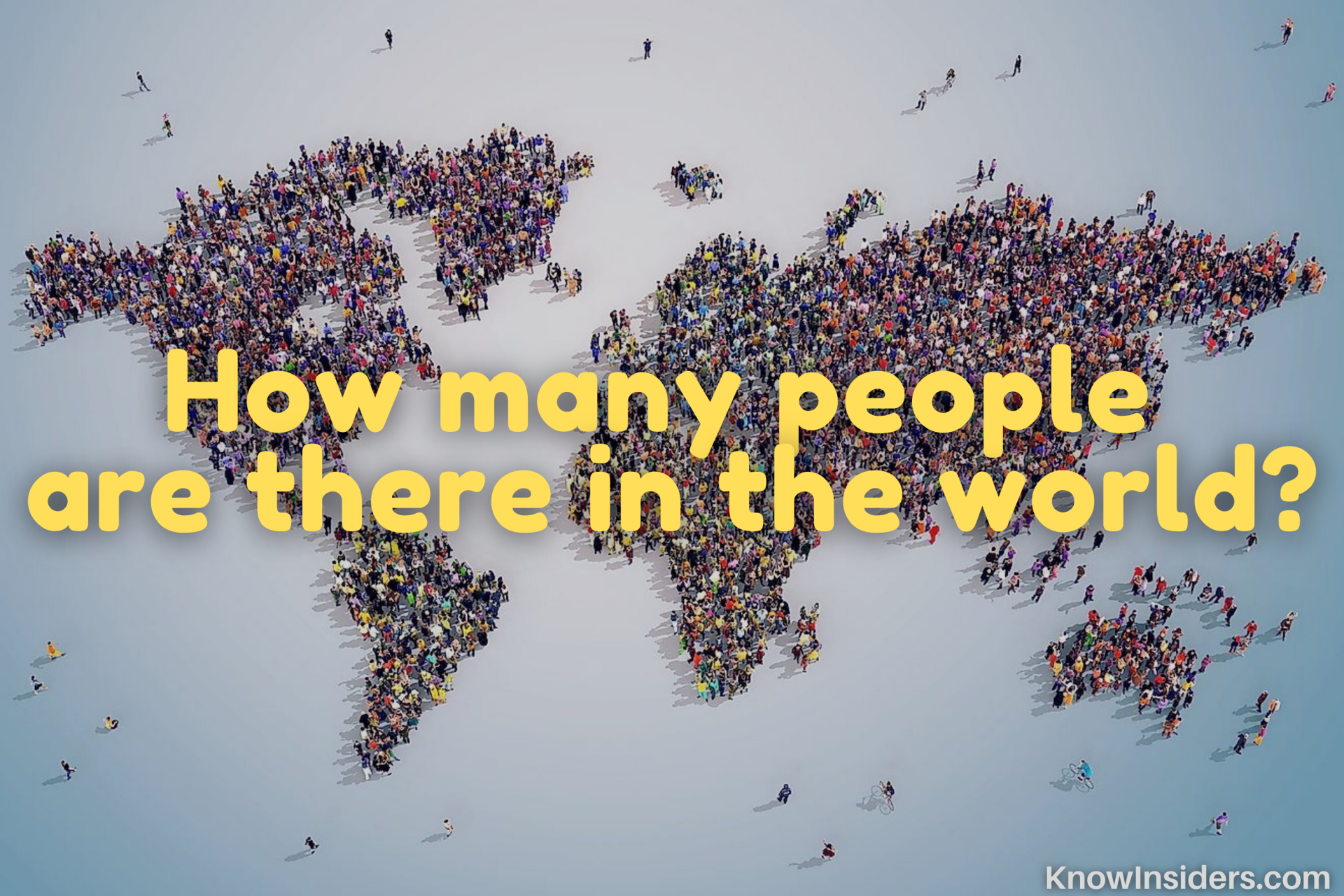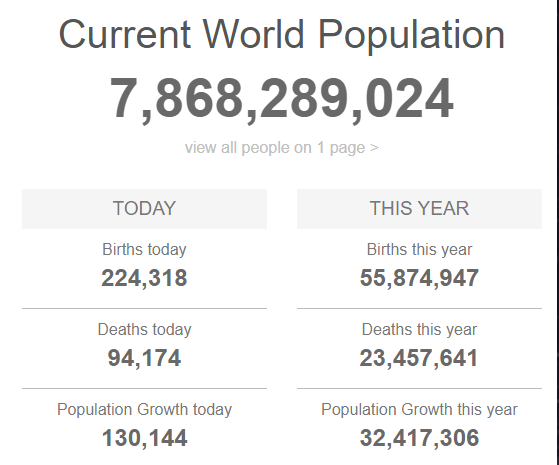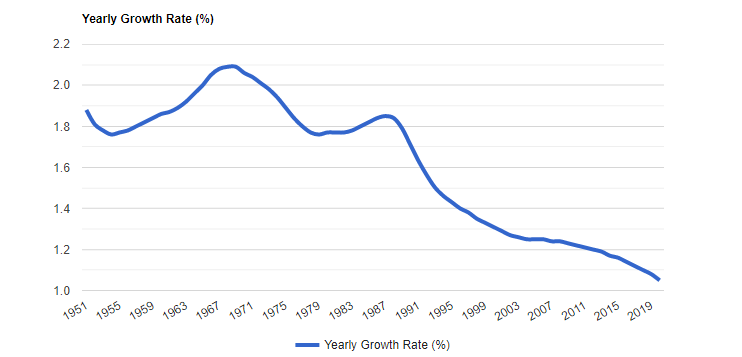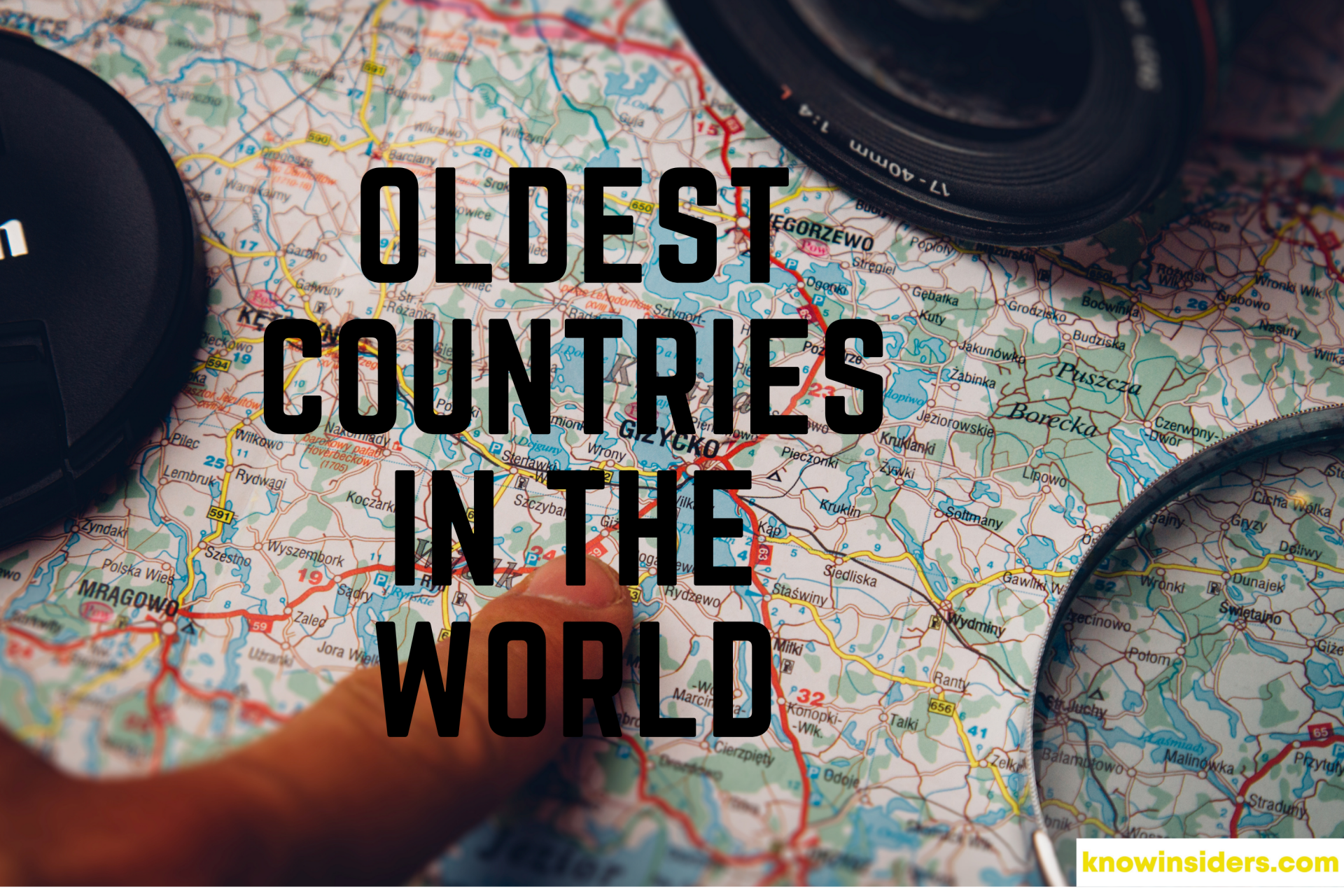How Many People Are There In The World: Population Update & Analysis
 |
The current world population is about 7.9 billion as of May 2021 according to the most recent United Nations estimates elaborated by Worldometer.
 |
| Photo: Worldometer |
Population in the world is currently (2020) growing at a rate of around 1.05% per year (down from 1.08% in 2019, 1.10% in 2018, and 1.12% in 2017). The current average population increase is estimated at 81 million people per year. The annual growth rate reached its peak in the late 1960s when it was at around 2%.
World Population: Past, Present, and Future
| Year | World Population | Yearly Change | Net Change | Density (P/Km²) | Urban Pop | Urban Pop % |
|---|---|---|---|---|---|---|
| 2020 | 7,794,798,739 | 1.05 % | 81,330,639 | 52 | 4,378,993,944 | 56 % |
| 2019 | 7,713,468,100 | 1.08 % | 82,377,060 | 52 | 4,299,438,618 | 56 % |
| 2018 | 7,631,091,040 | 1.10 % | 83,232,115 | 51 | 4,219,817,318 | 55 % |
| 2017 | 7,547,858,925 | 1.12 % | 83,836,876 | 51 | 4,140,188,594 | 55 % |
| 2016 | 7,464,022,049 | 1.14 % | 84,224,910 | 50 | 4,060,652,683 | 54 % |
| 2015 | 7,379,797,139 | 1.16 % | 84,506,374 | 50 | 3,981,497,663 | 54 % |
| 2014 | 7,295,290,765 | 1.17 % | 84,708,789 | 49 | 3,902,831,934 | 53 % |
| 2013 | 7,210,581,976 | 1.19 % | 84,753,917 | 48 | 3,824,990,329 | 53 % |
| 2012 | 7,125,828,059 | 1.20 % | 84,633,758 | 48 | 3,747,842,586 | 53 % |
| 2011 | 7,041,194,301 | 1.21 % | 84,370,698 | 47 | 3,671,423,872 | 52 % |
| 2010 | 6,956,823,603 | 1.22 % | 84,056,510 | 47 | 3,594,868,146 | 52 % |
| 2009 | 6,872,767,093 | 1.23 % | 83,678,407 | 46 | 3,516,830,263 | 51 % |
| 2008 | 6,789,088,686 | 1.24 % | 83,142,076 | 46 | 3,439,719,128 | 51 % |
| 2007 | 6,705,946,610 | 1.24 % | 82,428,777 | 45 | 3,363,609,560 | 50 % |
| 2006 | 6,623,517,833 | 1.25 % | 81,610,806 | 44 | 3,289,446,226 | 50 % |
| 2005 | 6,541,907,027 | 1.25 % | 80,747,638 | 44 | 3,215,905,863 | 49 % |
| 2004 | 6,461,159,389 | 1.25 % | 79,974,275 | 43 | 3,143,044,892 | 49 % |
| 2003 | 6,381,185,114 | 1.26 % | 79,411,926 | 43 | 3,071,743,997 | 48 % |
| 2002 | 6,301,773,188 | 1.27 % | 79,146,582 | 42 | 3,001,808,223 | 48 % |
| 2001 | 6,222,626,606 | 1.29 % | 79,132,783 | 42 | 2,933,078,510 | 47 % |
| 2000 | 6,143,493,823 | 1.31 % | 79,254,768 | 41 | 2,868,307,513 | 47 % |
| 1999 | 6,064,239,055 | 1.33 % | 79,445,113 | 41 | 2,808,231,655 | 46 % |
| 1998 | 5,984,793,942 | 1.35 % | 79,748,154 | 40 | 2,749,213,598 | 46 % |
| 1997 | 5,905,045,788 | 1.38 % | 80,153,837 | 40 | 2,690,813,541 | 46 % |
| 1996 | 5,824,891,951 | 1.40 % | 80,678,972 | 39 | 2,632,941,583 | 45 % |
| 1995 | 5,744,212,979 | 1.43 % | 81,062,552 | 39 | 2,575,505,235 | 45 % |
| 1994 | 5,663,150,427 | 1.46 % | 81,552,881 | 38 | 2,518,254,111 | 44 % |
| 1993 | 5,581,597,546 | 1.50 % | 82,677,737 | 37 | 2,461,223,528 | 44 % |
| 1992 | 5,498,919,809 | 1.56 % | 84,630,365 | 37 | 2,404,337,297 | 44 % |
| 1991 | 5,414,289,444 | 1.63 % | 87,058,383 | 36 | 2,347,462,336 | 43 % |
| 1990 | 5,327,231,061 | 1.71 % | 89,789,503 | 36 | 2,290,228,096 | 43 % |
| 1989 | 5,237,441,558 | 1.79 % | 92,015,550 | 35 | 2,233,140,502 | 43 % |
| 1988 | 5,145,426,008 | 1.84 % | 92,903,861 | 35 | 2,176,126,537 | 42 % |
| 1987 | 5,052,522,147 | 1.85 % | 91,954,235 | 34 | 2,118,882,551 | 42 % |
| 1986 | 4,960,567,912 | 1.84 % | 89,646,172 | 33 | 2,062,604,394 | 42 % |
| 1985 | 4,870,921,740 | 1.82 % | 86,910,119 | 33 | 2,007,939,063 | 41 % |
| 1984 | 4,784,011,621 | 1.80 % | 84,442,317 | 32 | 1,955,106,433 | 41 % |
| 1983 | 4,699,569,304 | 1.78 % | 82,182,762 | 32 | 1,903,822,436 | 41 % |
| 1982 | 4,617,386,542 | 1.77 % | 80,389,780 | 31 | 1,854,134,229 | 40 % |
| 1981 | 4,536,996,762 | 1.77 % | 78,993,248 | 30 | 1,804,215,203 | 40 % |
| 1980 | 4,458,003,514 | 1.77 % | 77,497,414 | 30 | 1,754,201,029 | 39 % |
| 1979 | 4,380,506,100 | 1.76 % | 75,972,599 | 29 | 1,706,021,638 | 39 % |
| 1978 | 4,304,533,501 | 1.77 % | 75,027,441 | 29 | 1,659,306,117 | 39 % |
| 1977 | 4,229,506,060 | 1.80 % | 74,839,196 | 28 | 1,616,419,308 | 38 % |
| 1976 | 4,154,666,864 | 1.84 % | 75,186,258 | 28 | 1,577,376,141 | 38 % |
| 1975 | 4,079,480,606 | 1.89 % | 75,686,434 | 27 | 1,538,624,994 | 38 % |
| 1974 | 4,003,794,172 | 1.94 % | 76,013,934 | 27 | 1,501,134,655 | 37 % |
| 1973 | 3,927,780,238 | 1.98 % | 76,129,993 | 26 | 1,462,178,370 | 37 % |
| 1972 | 3,851,650,245 | 2.01 % | 75,890,628 | 26 | 1,424,734,781 | 37 % |
| 1971 | 3,775,759,617 | 2.04 % | 75,322,571 | 25 | 1,388,834,099 | 37 % |
| 1970 | 3,700,437,046 | 2.06 % | 74,756,419 | 25 | 1,354,215,496 | 37 % |
| 1969 | 3,625,680,627 | 2.09 % | 74,081,500 | 24 | 1,319,833,474 | 36 % |
| 1968 | 3,551,599,127 | 2.09 % | 72,829,165 | 24 | 1,285,933,432 | 36 % |
| 1967 | 3,478,769,962 | 2.08 % | 70,847,332 | 23 | 1,252,566,565 | 36 % |
| 1966 | 3,407,922,630 | 2.05 % | 68,339,033 | 23 | 1,219,993,032 | 36 % |
| 1965 | 3,339,583,597 | 2.00 % | 65,605,259 | 22 | 1,188,469,224 | 36 % |
| 1964 | 3,273,978,338 | 1.96 % | 62,977,329 | 22 | 1,157,813,355 | 35 % |
| 1963 | 3,211,001,009 | 1.92 % | 60,580,214 | 22 | 1,122,561,940 | 35 % |
| 1962 | 3,150,420,795 | 1.89 % | 58,577,288 | 21 | 1,088,376,703 | 35 % |
| 1961 | 3,091,843,507 | 1.87 % | 56,893,759 | 21 | 1,055,435,648 | 34 % |
| 1960 | 3,034,949,748 | 1.86 % | 55,373,563 | 20 | 1,023,845,517 | 34 % |
| 1959 | 2,979,576,185 | 1.84 % | 53,889,480 | 20 | 992,820,546 | 33 % |
| 1958 | 2,925,686,705 | 1.82 % | 52,380,615 | 20 | 962,537,113 | 33 % |
| 1957 | 2,873,306,090 | 1.80 % | 50,862,808 | 19 | 933,113,168 | 32 % |
| 1956 | 2,822,443,282 | 1.78 % | 49,423,346 | 19 | 904,685,164 | 32 % |
| 1955 | 2,773,019,936 | 1.77 % | 48,173,195 | 19 | 877,008,842 | 32 % |
| 1954 | 2,724,846,741 | 1.76 % | 47,237,781 | 18 | 850,179,106 | 31 % |
| 1953 | 2,677,608,960 | 1.78 % | 46,747,398 | 18 | 824,289,989 | 31 % |
| 1952 | 2,630,861,562 | 1.81 % | 46,827,301 | 18 | 799,282,533 | 30 % |
| 1951 | 2,584,034,261 | 1.88 % | 47,603,112 | 17 | 775,067,697 | 30 % |
| 1927 | 2,000,000,000 | |||||
| 1900 | 1,600,000,000 | |||||
| 1850 | 1,200,000,000 | |||||
| 1804 | 1,000,000,000 | |||||
| 1760 | 770,000,000 | |||||
| 1700 | 610,000,000 | |||||
| 1600 | 500,000,000 | |||||
| 1500 | 450,000,000 | |||||
| 1400 | 350,000,000 | |||||
| 1200 | 360,000,000 | |||||
| 1100 | 320,000,000 | |||||
| 1000 | 275,000,000 | |||||
| 900 | 240,000,000 | |||||
| 800 | 220,000,000 | |||||
| 700 | 210,000,000 | |||||
| 600 | 200,000,000 | |||||
| 200 | 190,000,000 | |||||
| -200 | 150,000,000 | |||||
| -500 | 100,000,000 | |||||
| -1000 | 50,000,000 | |||||
| -2000 | 27,000,000 | |||||
| -3000 | 14,000,000 | |||||
| -4000 | 7,000,000 | |||||
| -5000 | 5,000,000 |
At the dawn of agriculture, about 8000 B.C., the population of the world was approximately 5 million. Over the 8,000-year period up to 1 A.D. it grew to 200 million (some estimate 300 million or even 600, suggesting how imprecise population estimates of early historical periods can be), with a growth rate of under 0.05% per year.
A tremendous change occurred with the industrial revolution: whereas it had taken all of human history until around 1800 for world population to reach one billion, the second billion was achieved in only 130 years (1930), the third billion in 30 years (1960), the fourth billion in 15 years (1974), and the fifth billion in only 13 years (1987).
During the 20th century alone, the population in the world has grown from 1.65 billion to 6 billion.
In 1970, there were roughly half as many people in the world as there are now. Because of declining growth rates, it will now take over 200 years to double again.
Growth Rate
 |
| Photo: Worldometer |
Population in the world is currently (2020) growing at a rate of around 1.05% per year (down from 1.08% in 2019, 1.10% in 2018, and 1.12% in 2017). The current average population increase is estimated at 81 million people per year.
Annual growth rate reached its peak in the late 1960s, when it was at around 2%. The rate of increase has nearly halved since then, and will continue to decline in the coming years.
World population will therefore continue to grow in the 21st century, but at a much slower rate compared to the recent past. World population has doubled (100% increase) in 40 years from 1959 (3 billion) to 1999 (6 billion). It is now estimated that it will take another nearly 40 years to increase by another 50% to become 9 billion by 2037.
The latest world population projections indicate that world population will reach 10 billion persons in the year 2057.
World Population Forecast (2020-2050)
| Year (July 1) | Population | Yearly % Change | Yearly Change | Median Age | Fertility Rate | Density (P/Km²) | Urban Pop % | Urban Population |
|---|---|---|---|---|---|---|---|---|
| 2020 | 7,794,798,739 | 1.10 % | 83,000,320 | 31 | 2.47 | 52 | 56.2 % | 4,378,993,944 |
| 2025 | 8,184,437,460 | 0.98 % | 77,927,744 | 32 | 2.54 | 55 | 58.3 % | 4,774,646,303 |
| 2030 | 8,548,487,400 | 0.87 % | 72,809,988 | 33 | 2.62 | 57 | 60.4 % | 5,167,257,546 |
| 2035 | 8,887,524,213 | 0.78 % | 67,807,363 | 34 | 2.70 | 60 | 62.5 % | 5,555,833,477 |
| 2040 | 9,198,847,240 | 0.69 % | 62,264,605 | 35 | 2.77 | 62 | 64.6 % | 5,938,249,026 |
| 2045 | 9,481,803,274 | 0.61 % | 56,591,207 | 35 | 2.85 | 64 | 66.6 % | 6,312,544,819 |
| 2050 | 9,735,033,990 | 0.53 % | 50,646,143 | 36 | 2.95 | 65 | 68.6 % | 6,679,756,162 |
World Population Milestones
10 Billion (2057): The United Nations projects world population to reach 10 billion in the year 2057.
9 Billion (2037): World population is expected to reach 9 billion in the year 2037.
8 Billion (2023): World population is expected to reach 8 billion people in 2023 according to the United Nations (in 2026 according to the U.S. Census Bureau).
7.9 Billion (2021): The current world population is 7.9 billion as of May 2021 according to the most recent United Nations estimates elaborated by Worldometer. The term "World Population" refers to the human population (the total number of humans currently living) of the world.
7 Billion (2011): According to the United Nations, world population reached 7 Billion on October 31, 2011. The US Census Bureau made a lower estimate, for which the 7 billion mark was only reached on March 12, 2012.
6 Billion (1999): According to the United Nations, the 6 billion figure was reached on October 12, 1999 (celebrated as the Day of 6 Billion). According to the U.S. Census Bureau instead, the six billion milestone was reached on July 22, 1999, at about 3:49 AM GMT. Yet, according to the U.S. Census, the date and time of when 6 billion was reached will probably change because the already uncertain estimates are constantly being updated.
| World population to reach 9.7 billion in 2050 The world population is expected to increase by 2 billion persons in the next 30 years, from 7.7 billion currently to 9.7 billion in 2050, according to a United Nations report. The World Population Prospects 2019: Highlights, which is published by the Population Division of the UN Department of Economic and Social Affairs, provides a comprehensive overview of global demographic patterns and prospects, reports UNB. The study concluded the world’s population could reach its peak around the end of the current century, at a level of nearly 11 billion. The report also confirmed the world’s population is growing older due to increasing life expectancy and falling fertility levels, and the number of countries experiencing a reduction in population size is growing. |
READ MORE: Facts About the Countries in the World: How Many, Population, Oldest, Youngest, Richest
 Which Country Is The Most Powerful In The World? Which Country Is The Most Powerful In The World? Defining the world’s most powerful countries is not always clear-cut and can be subjective. The most powerful nations are the ones that shape global ... |
 What Are 9 Oldest Countries In The World? What Are 9 Oldest Countries In The World? Let’s find out interesting facts about 9 oldest countries in the world! |
 What is the Drunkest Country in the World - Moldova What is the Drunkest Country in the World - Moldova Alcohol, wine and beers are favourite world wide, but there is countries that drink half of their wages into alcohol. To know more about Moldova ... |


























